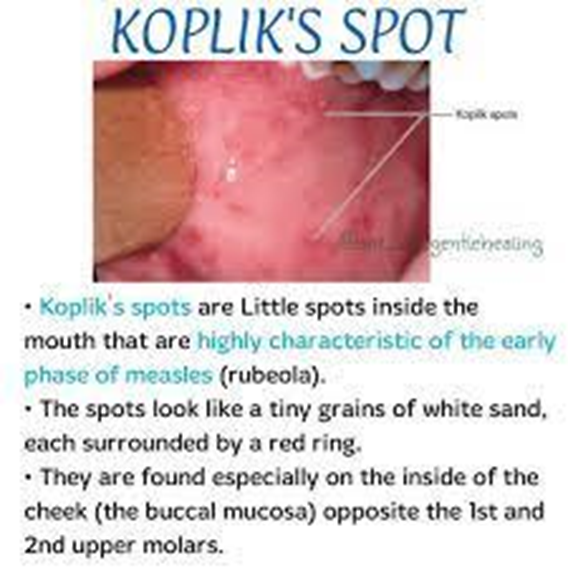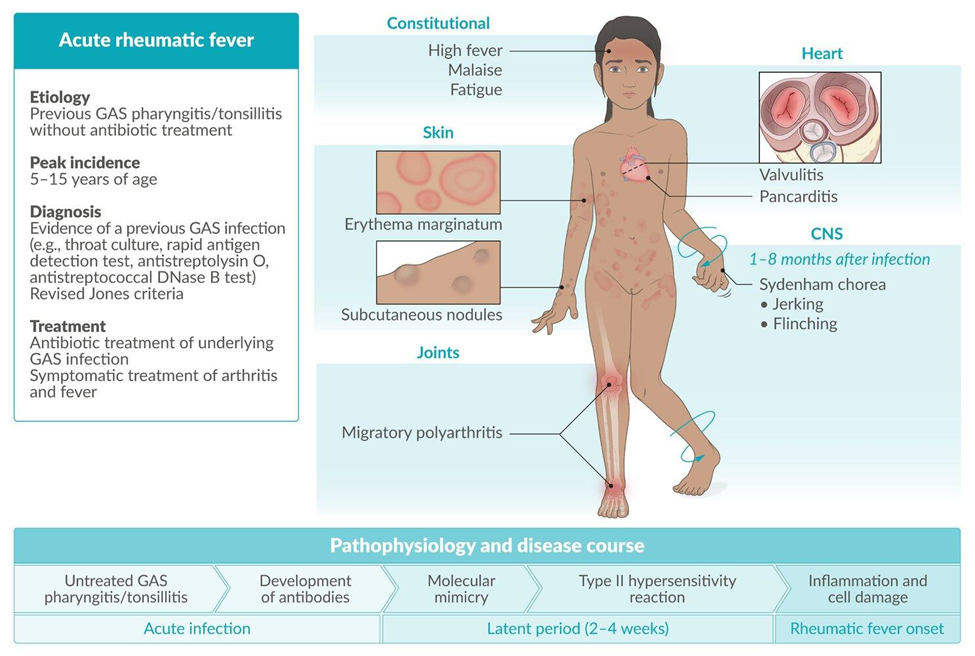The nurse caring for a child diagnosed with rubeola (measles) notes that the pediatrician has documented the presence of Koplik's spots. On the basis of this documentation, which observation is expected?
whitish vesicles located across the chest
Small blue-white spots with a red base found on the buccal mucosa
Pinpoint petechiae noted on both legs
Petechiae spots that are reddish and pinpoint on the soft palate
The Correct Answer is B
A. Whitish vesicles located across the chest:
Incorrect: This description does not match the characteristic appearance or location of Koplik's spots in measles.
B. Small blue-white spots with a red base found on the buccal mucosa:
Correct Answer: Koplik's spots are small, blue-white spots with a red base that typically appear on the buccal mucosa (inner lining of the cheeks). These spots are characteristic of measles and are considered a diagnostic feature.
C. Pinpoint petechiae noted on both legs:
Incorrect: Petechiae are small, reddish-purple spots that result from bleeding under the skin. They are not characteristic of Koplik's spots in measles.
D. Petechiae spots that are reddish and pinpoint on the soft palate:
Incorrect: While petechiae can occur in various conditions, they are not characteristic of Koplik's spots in measles. Koplik's spots specifically manifest as small blue-white spots on the buccal mucosa.

Nursing Test Bank
Naxlex Comprehensive Predictor Exams
Related Questions
Correct Answer is ["A","C","D"]
Explanation
A.Reduce exposure to environmental organisms.
Explanation: Minimizing the child's exposure to environmental organisms helps reduce the risk of infections. This includes practices such as maintaining a clean environment and promoting good hygiene.
B. Maintain the child in a semiprivate room.
Explanation: The type of room (semiprivate or private) may not be directly related to infection control. However, maintaining a clean and controlled environment is important.
C.Use strict aseptic technique for all procedures.
Explanation: Strict aseptic technique is crucial to prevent the introduction of pathogens during procedures. This involves maintaining a sterile field and using appropriate infection control measures during medical interventions.
D.Ensure that anyone entering the child's room wears a mask.
Explanation: Wearing a mask helps prevent the spread of respiratory infections, which can be particularly risky for immunocompromised children. It is a measure to protect the child from potential airborne pathogens.
E. Apply firm pressure to a needlestick area for at least 10 minutes.
Explanation: Applying firm pressure to a needlestick area is relevant in the context of preventing bleeding or hematoma formation but is not directly related to infection control.
Correct Answer is A
Explanation
A. "This test will confirm if your child had a recent streptococcal infection."
Explanation:
The anti-streptolysin O (ASO) titer is a blood test used to detect the presence of antibodies against streptolysin O, a toxin produced by group A Streptococcus bacteria. A rise in ASO titers indicates a recent streptococcal infection. It does not confirm rheumatic fever directly but helps in identifying a recent streptococcal infection, which is a predisposing factor for rheumatic fever.
B. "This test will indicate if your child has rheumatic fever."
Explanation: While a positive ASO titer may suggest a recent streptococcal infection, it does not directly indicate rheumatic fever. The diagnosis of rheumatic fever involves a combination of clinical criteria, including evidence of a recent streptococcal infection, along with specific signs and symptoms.
C. "This test will confirm if your child has immunity to streptococcal bacteria."
Explanation: The ASO titer does not measure immunity to streptococcal bacteria. It specifically detects antibodies produced in response to a recent streptococcal infection.
D. "This test will indicate if your child has a therapeutic blood level of an aminoglycoside."
Explanation: The ASO titer is not used to monitor therapeutic blood levels of aminoglycosides. It is specific to detecting antibodies related to streptococcal infections and is not related to aminoglycoside therapy.

Whether you are a student looking to ace your exams or a practicing nurse seeking to enhance your expertise , our nursing education contents will empower you with the confidence and competence to make a difference in the lives of patients and become a respected leader in the healthcare field.
Visit Naxlex, invest in your future and unlock endless possibilities with our unparalleled nursing education contents today
Report Wrong Answer on the Current Question
Do you disagree with the answer? If yes, what is your expected answer? Explain.
Kindly be descriptive with the issue you are facing.
